An Assessment of the Impact of Locally Recycled Cementitious Replacement Materials on the Strength of the Ultra-High-Performance Concrete
Abstract
:1. Introduction
2. Materials and Methods
2.1. Materials
2.2. Mixture Proportion
2.3. Experimental Methods
2.3.1. Mixing and Handling UHPC Mix
2.3.2. Test Methods
3. Results
3.1. UHPC’s Workability and Entrapped Air Content
3.2. Compressive Strength
3.3. Flexural Strength
3.4. Tensile Strength
4. Conclusions
- RHA improves workability but can increase entrapped air at higher percentages (15–20%).
- Replacing 50% of SF with RHA (SF10RHA10) enhances compressive strength beyond that of 100% SF. The compressive strength increases by 15.7% compared to the sample with only 10% SF and by 4% compared to the sample with 20% SF.
- A mixture of 10% RHA and 10% SF enhances both the workability and compressive strength of UHPC. The optimal RHA–SF ratios lead to improved flexural and tensile strengths, with tensile strength increasing by approximately 20% compared to UHPC samples containing 10% SF and about 5% compared to those with 20% SF.
- The stress–strain analysis shows increased ductility and fracture energy with 5% to 15% RHA. This suggests that RHA can effectively substitute a portion of SF.
Author Contributions
Funding
Institutional Review Board Statement
Informed Consent Statement
Data Availability Statement
Acknowledgments
Conflicts of Interest
References
- WMO. Provisional State of the Global Climate; WMO: Geneva, Switzerland, 2023. [Google Scholar]
- Tran, M.Q.; Sousa, H.S.; Texeira, E.; Matos, J.C. Flood Vulnerability Index (FVI) of Infrastructures for Reducing Adverse Flood Events. In Life-Cycle of Structures and Infrastructure Systems—Proceedings of the 8th International Symposium on Life-Cycle Civil Engineering, IALCCE 2023, Milan, Italy, 2–6 July 2023; CRC Press: Boca Raton, FL, USA, 2023; pp. 4155–4162. [Google Scholar] [CrossRef]
- Bento, A.M.; Tran, M.Q. Melhoria Da Precisão e Otimização Do Método Do Índice de Vulnerabilidade Às Cheias. Available online: https://www.researchgate.net/publication/366849840 (accessed on 19 July 2024).
- Yu, R.; Shui, Z. Efficient Reuse of the Recycled Construction Waste Cementitious Materials. J. Clean. Prod. 2014, 78, 202–207. [Google Scholar] [CrossRef]
- Cruz, M.L.S.; Carrillo, J.; De Almeida, S.F.M. Effect of Thermal Residual Stresses on Buckling and Post-Buckling Properties of Laminated Composites Perimetrally Reinforced. Lat. Am. J. Solids Struct. 2016, 13, 435–455. [Google Scholar] [CrossRef]
- Yang, R.; Yu, R.; Shui, Z.; Gao, X.; Xiao, X.; Zhang, X.; Wang, Y.; He, Y. Low Carbon Design of an Ultra-High Performance Concrete (UHPC) Incorporating Phosphorous Slag. J. Clean. Prod. 2019, 240, 118157. [Google Scholar] [CrossRef]
- Qian, D.; Yu, R.; Shui, Z.; Sun, Y.; Jiang, C.; Zhou, F.; Ding, M.; Tong, X.; He, Y. A Novel Development of Green Ultra-High Performance Concrete (UHPC) Based on Appropriate Application of Recycled Cementitious Material. J. Clean. Prod. 2020, 261, 121231. [Google Scholar] [CrossRef]
- Jiao, Y.; Zhang, Y.; Guo, M.; Zhang, L.; Ning, H.; Liu, S. Mechanical and Fracture Properties of Ultra-High Performance Concrete (UHPC) Containing Waste Glass Sand as Partial Replacement Material. J. Clean. Prod. 2020, 277, 123501. [Google Scholar] [CrossRef]
- Saradar, A.; Nemati, P.; Paskiabi, A.S.; Moein, M.M.; Moez, H.; Vishki, E.H. Prediction of Mechanical Properties of Lightweight Basalt Fiber Reinforced Concrete Containing Silica Fume and Fly Ash: Experimental and Numerical Assessment. J. Build. Eng. 2020, 32, 32. [Google Scholar] [CrossRef]
- Sadrolodabaee, P.; Claramunt, J.; Ardanuy, M.; de la Fuente, A. Effect of Accelerated Aging and Silica Fume Addition on the Mechanical and Microstructural Properties of Hybrid Textile Waste-Flax Fabric-Reinforced Cement Composites. Cem. Concr. Compos. 2023, 135, 104829. [Google Scholar] [CrossRef]
- Cheraghalizadeh, R.; Akcaoglu, T. Properties of Self-Compacting Concrete Containing Olive Waste Ash. Cem. -Wapno-Beton Cem. Lime Concr. 2020, 25, 178–187. [Google Scholar] [CrossRef]
- Adesina, A.; de Azevedo, A.R.G.; Amin, M.; Hadzima-Nyarko, M.; Agwa, I.S.; Zeyad, A.M.; Tayeh, B.A. Fresh and Mechanical Properties Overview of Alkali-Activated Materials Made with Glass Powder as Precursor. Clean. Mater. 2022, 3, 100036. [Google Scholar] [CrossRef]
- Amin, M.; Zeyad, A.M.; Tayeh, B.A.; Saad Agwa, I. Effect of Ferrosilicon and Silica Fume on Mechanical, Durability, and Microstructure Characteristics of Ultra High-Performance Concrete. Constr. Build. Mater. 2022, 320, 126233. [Google Scholar] [CrossRef]
- Amin, M.; Abdel-Aziz, N.; Agwa, I.S.; El-Hassan, K.A. Properties and Microstructure of High Strength Concrete Incorporating Different Supplementary Cementitious Materials. Key Eng. Mater. 2022, 921, 247–257. [Google Scholar] [CrossRef]
- de Azevedo, A.R.G.; Amin, M.; Hadzima-Nyarko, M.; Saad Agwa, I.; Zeyad, A.M.; Tayeh, B.A.; Adesina, A. Possibilities for the Application of Agro-Industrial Wastes in Cementitious Materials: A Brief Review of the Brazilian Perspective. Clean. Mater. 2022, 3, 100040. [Google Scholar] [CrossRef]
- Nguyen, D.T.; Nguyen, N.T.; Pham, H.N.T.; Phung, H.H.; Nguyen, H. Van Rice Husk Ash and Its Utilization in Soil Improvement: An Overview. J. Min. Earth Sci. 2020, 61, 1–11. [Google Scholar] [CrossRef]
- Pitoyo, P.; Subandi, S.; Azzahra, R.; Vebrian, V. The Effects of Rice Husk Ash and Paper Waste Ash as Admixture to Self Compacting Concrete. Int. J. Mech. Prod. Eng. Res. Dev. 2020, 10, 12793–12800. [Google Scholar] [CrossRef]
- Singh, A.; Kumar, R.; Mehta, P.K.; Tripathi, D. Properties of Binary Admixture Mixed SCC Exposed to Sulphate Environment. Lect. Notes Civ. Eng. 2022, 222, 129–136. [Google Scholar] [CrossRef]
- Schmidt, M.; Fehling, E. Ultra-High-Performance Concrete: Research, Development and Application in Europe. In Proceedings of the SP-228: 7th Intl Symposium on the Utilization of High-Strength/High-Performance Concrete; American Concrete Institute: Farmington Hills, MI, USA, 2005; pp. 51–77. [Google Scholar] [CrossRef]
- Van Tuan, N.; Ye, G.; Van Breugel, K.; Copuroglu, O. Hydration and Microstructure of Ultra High Performance Concrete Incorporating Rice Husk Ash. Cem. Concr. Res. 2011, 41, 1104–1111. [Google Scholar] [CrossRef]
- Wang, W.H.; Meng, Y.F.; Wang, D.Z. Effect of Rice Husk Ash on High-Temperature Mechanical Properties and Microstructure of Concrete. Kem. U Ind. J. Chem. Chem. Eng. 2017, 66, 157–164. [Google Scholar] [CrossRef]
- TCVN 2682 Portland Cements—Specifications. Available online: https://caselaw.vn/van-ban-phap-luat/253583-tieu-chuan-quoc-gia-tcvn-2682-2009-ve-xi-mang-pooc-lang-yeu-cau-ky-thuat-nam-2009 (accessed on 19 July 2024).
- ASTM C1240-15; Standard Specification for Silica Fume Used in Cementitious Mixtures. ASTM International: West Conshohocken, PA, USA, 2020. Available online: https://www.astm.org/c1240-15.html (accessed on 19 July 2024).
- Basri, M.S.M.; Mustapha, F.; Mazlan, N.; Ishak, M.R. Optimization of Rice Husk Ash-Based Geopolymers Coating Composite for Enhancement in Flexural Properties and Microstructure Using Response Surface Methodology. Coatings 2020, 10, 165. [Google Scholar] [CrossRef]
- Khan, R.; Jabbar, A.; Ahmad, I.; Khan, W.; Khan, A.N.; Mirza, J. Reduction in Environmental Problems Using Rice-Husk Ash in Concrete. Constr. Build. Mater. 2012, 30, 360–365. [Google Scholar] [CrossRef]
- Yu, L.; Wu, R. Using Graphene Oxide to Improve the Properties of Ultra-High-Performance Concrete with Fine Recycled Aggregate. Constr. Build. Mater. 2020, 259, 120657. [Google Scholar] [CrossRef]
- Nguyen, N.T.T.; Ngo, T.V.; Nguyen, K.K.; Vu, V.Q.; Xia, Y.; Tran, M.Q.; Dang, H.T.; Matos, J.; Dang, S.N. Effects of Fly Ash and Graphene Oxide in Cement Mortar Considering the Local Recycled Material Context. Appl. Sci. 2024, 14, 6140. [Google Scholar] [CrossRef]
- Faried, A.S.; Mostafa, S.A.; Tayeh, B.A.; Tawfik, T.A. The Effect of Using Nano Rice Husk Ash of Different Burning Degrees on Ultra-High-Performance Concrete Properties. Constr. Build. Mater. 2021, 290, 123279. [Google Scholar] [CrossRef]
- Van Tuan, N.; Ye, G.; Van Breugel, K.; Fraaij, A.L.A.; Bui, D.D. The Study of Using Rice Husk Ash to Produce Ultra High Performance Concrete. Constr. Build. Mater. 2011, 25, 2030–2035. [Google Scholar] [CrossRef]
- Shi, Y.; Long, G.; Zeng, X.; Xie, Y.; Wang, H. Green Ultra-High Performance Concrete with Very Low Cement Content. Constr. Build. Mater. 2021, 303, 124482. [Google Scholar] [CrossRef]
- Wille, K.; Naaman, A.E.; El-Tawil, S.; Parra-Montesinos, G.J. Ultra-High Performance Concrete and Fiber Reinforced Concrete: Achieving Strength and Ductility without Heat Curing. Mater. Struct. 2012, 45, 309–324. [Google Scholar] [CrossRef]
- Randl, N.; Steiner, T.; Ofner, S.; Baumgartner, E.; Mészöly, T. Development of UHPC Mixtures from an Ecological Point of View. Constr. Build. Mater. 2014, 67, 373–378. [Google Scholar] [CrossRef]
- TCVN 13735 Concrete—Ultra-High Performance Concrete (UHPC)—Technical Requirements and Test Methods. 2023.
- ASTM C230/C230M-21; Standard Specification for Flow Table for Use in Tests of Hydraulic Cement. ASTM International: West Conshohocken, PA, USA, 2023. Available online: https://www.astm.org/c0230_c0230m-21.html (accessed on 19 July 2024).
- ASTM C185; Standard Test Method for Air Content of Hydraulic Cement Mortar. ASTM International: West Conshohocken, PA, USA, 2020. Available online: https://www.astm.org/c0185-20.html (accessed on 6 August 2024).
- ASTM C39/C39M; Standard Test Method for Compressive Strength of Cylindrical Concrete Specimens. ASTM International: West Conshohocken, PA, USA, 2024. Available online: https://www.astm.org/c0039_c0039m-24.html (accessed on 6 August 2024).
- ASTM C78; Standard Test Method for Flexural Strength of Concrete (Using Simple Beam with Third-Point Loading). ASTM International: West Conshohocken, PA, USA, 2010. Available online: https://www.astm.org/standards/c78 (accessed on 6 August 2024).
- ASTM B557M; Standard Test Methods for Tension Testing Wrought and Cast Aluminum- and Magnesium-Alloy Products (Metric). ASTM International: West Conshohocken, PA, USA, 2023. Available online: https://www.astm.org/b0557m-15r23.html (accessed on 6 August 2024).
- ASTM E8/E8M; Standard Test Methods for Tension Testing of Metallic Materials. ASTM International: West Conshohocken, PA, USA, 2024. Available online: https://www.astm.org/e0008_e0008m-24.html (accessed on 6 August 2024).
- ASTM D638; Standard Test Method for Tensile Properties of Plastics. ASTM International: West Conshohocken, PA, USA, 2022. Available online: https://www.astm.org/d0638-22.html (accessed on 6 August 2024).
- Liao, W.C.; Chen, P.S.; Hung, C.W.; Wagh, S.K. An Innovative Test Method for Tensile Strength of Concrete by Applying the Strut-and-Tie Methodology. Materials 2020, 13, 2776. [Google Scholar] [CrossRef]
- Zhou, Z.; Qiao, P. Direct Tension Test for Characterization of Tensile Behavior of Ultra-High Performance Concrete. J. Test. Eval. 2020, 48, 2730–2749. [Google Scholar] [CrossRef]
- Schröfl, C.; Gruber, M.; Plank, J. Preferential Adsorption of Polycarboxylate Superplasticizers on Cement and Silica Fume in Ultra-High Performance Concrete (UHPC). Cem. Concr. Res. 2012, 42, 1401–1408. [Google Scholar] [CrossRef]
- Ye, J.; Cui, C.; Yu, J.; Yu, K.; Xiao, J. Fresh and Anisotropic-Mechanical Properties of 3D Printable Ultra-High Ductile Concrete with Crumb Rubber. Compos. B Eng. 2021, 211, 108639. [Google Scholar] [CrossRef]
- Zhang, Q.; Shu, X.; Yang, Y.; Wang, X.; Liu, J.; Ran, Q. Preferential Adsorption of Superplasticizer on Cement/Silica Fume and Its Effect on Rheological Properties of UHPC. Constr. Build. Mater. 2022, 359, 129519. [Google Scholar] [CrossRef]
- Huang, H.; Gao, X.; Wang, H.; Ye, H. Influence of Rice Husk Ash on Strength and Permeability of Ultra-High Performance Concrete. Constr. Build. Mater. 2017, 149, 621–628. [Google Scholar] [CrossRef]
- Richard, P.; Cheyrezy, M. Composition of Reactive Powder Concretes. Cem. Concr. Res. 1995, 25, 1501–1511. [Google Scholar] [CrossRef]
- Sadrolodabaee, P.; de la Fuente, A.; Ardanuy, M.; Claramunt, J. Mechanical Performance of Aged Cement-Based Matrices Reinforced with Recycled Aramid Textile Nonwoven Fabric: Comparison with Other FRCMs. Case Stud. Constr. Mater. 2024, 20, e02994. [Google Scholar] [CrossRef]
- Zhang, P.; Zhao, Y.; Li, Q.; Zhang, T.; Wang, P. Mechanical Properties of Fly Ash Concrete Composite Reinforced with Nano-SiO2 and Steel Fibre. Available online: https://www.researchgate.net/publication/264708185_Mechanical_properties_of_fly_ash_concrete_composite_reinforced_with_nano-SiO2_and_steel_fibre (accessed on 19 July 2024).
- Zhang, P.; Wan, J.; Wang, K.; Li, Q. Influence of Nano-SiO2 on Properties of Fresh and Hardened High Performance Concrete: A State-of-the-Art Review. Constr. Build. Mater. 2017, 148, 648–658. [Google Scholar] [CrossRef]
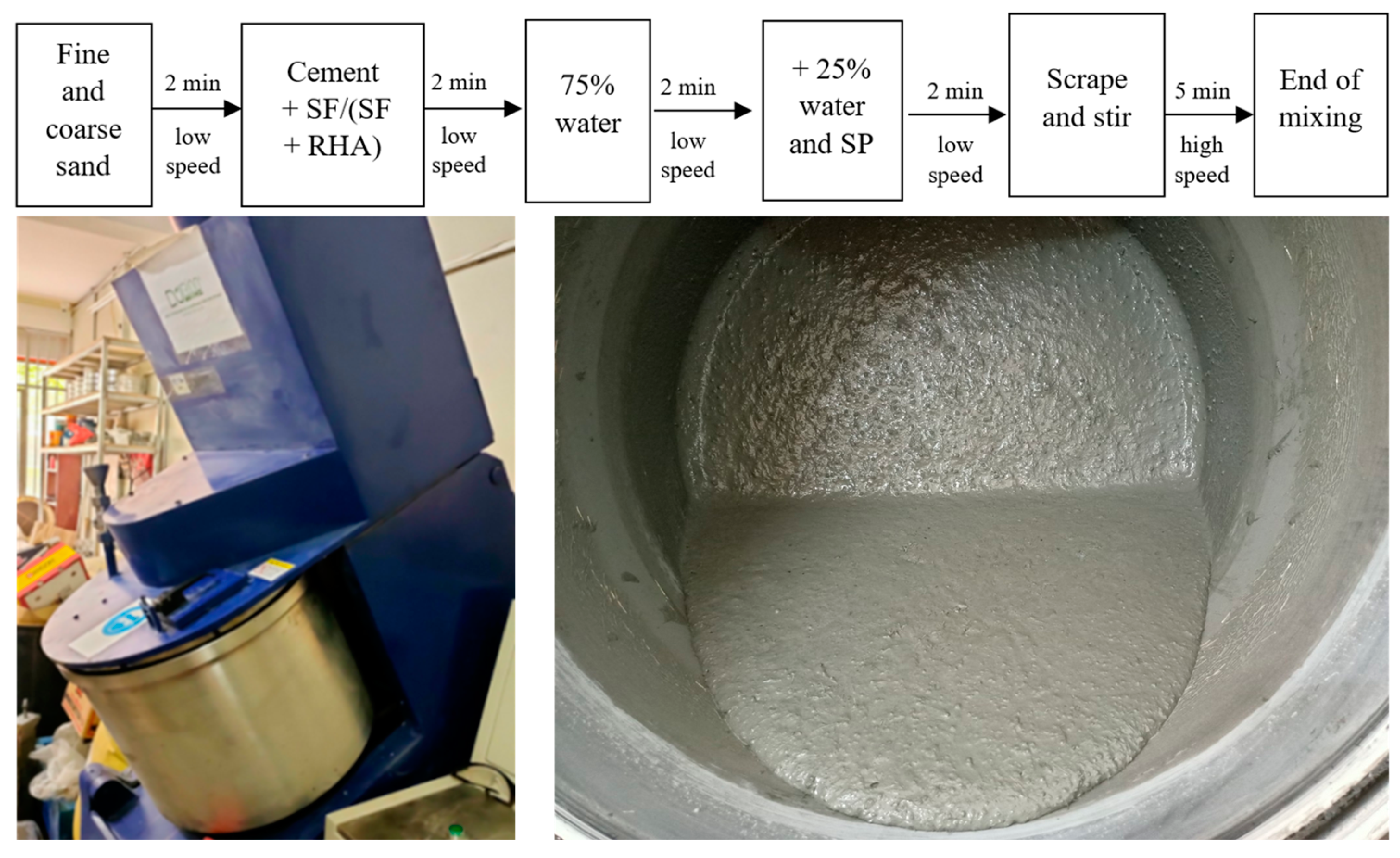



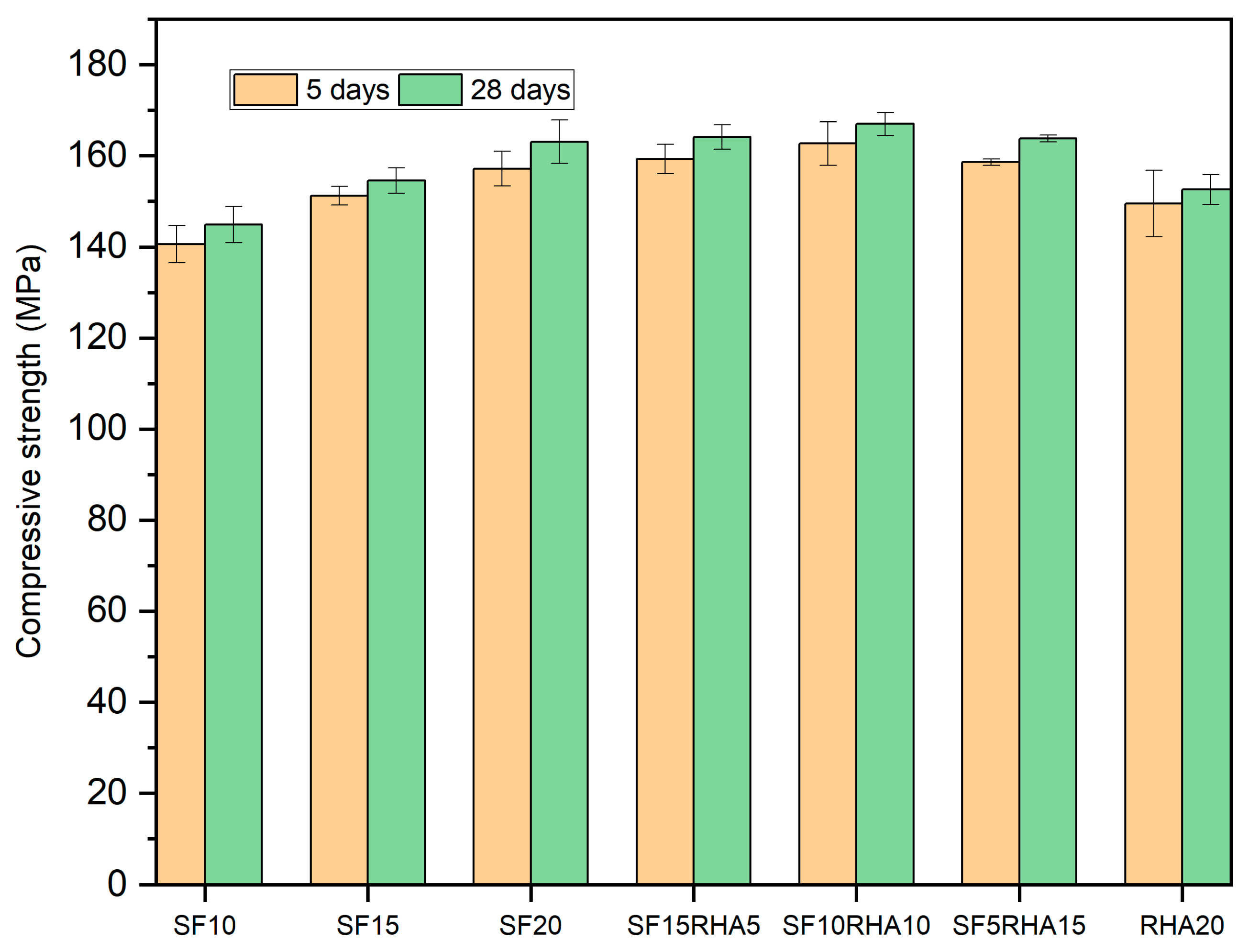
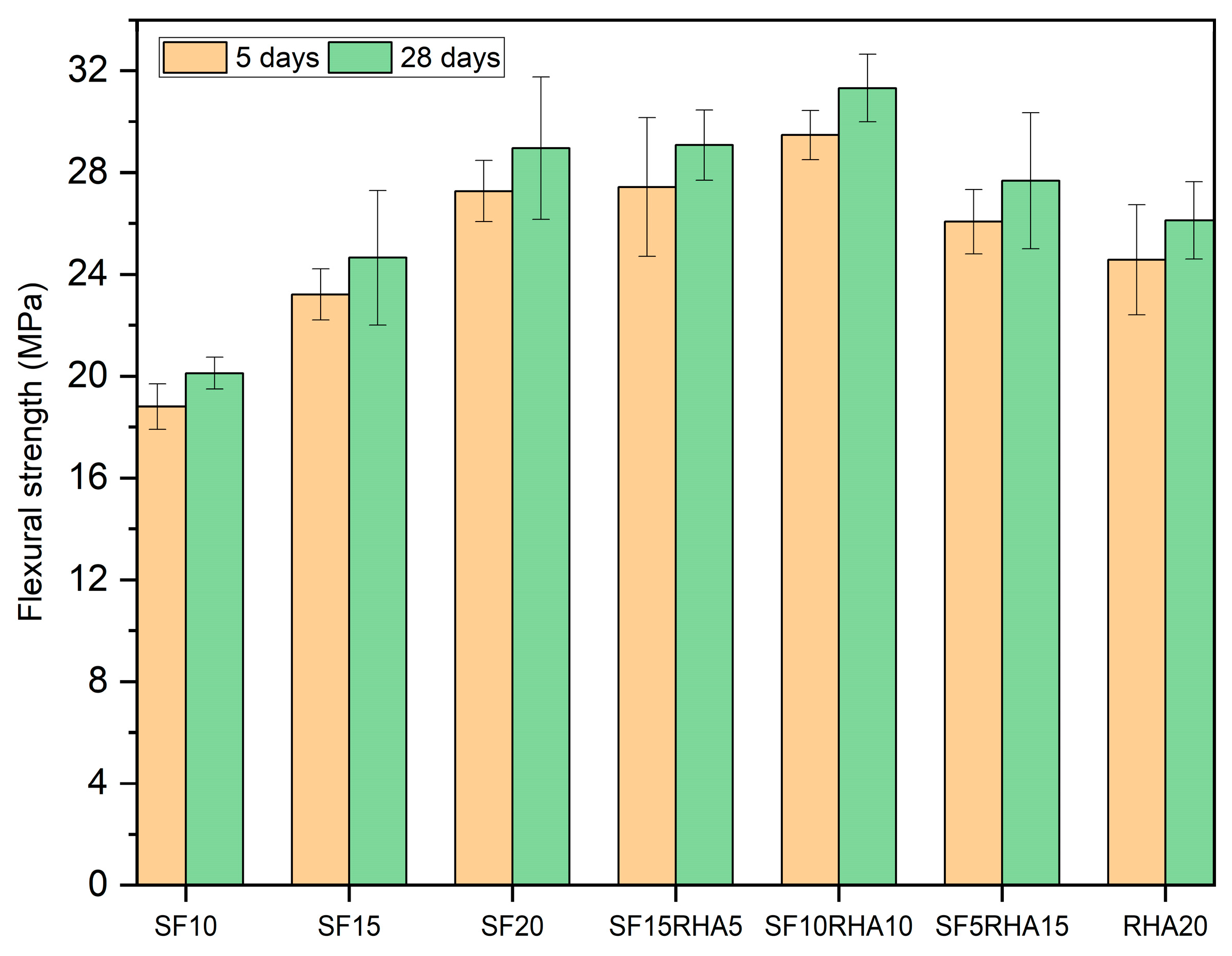
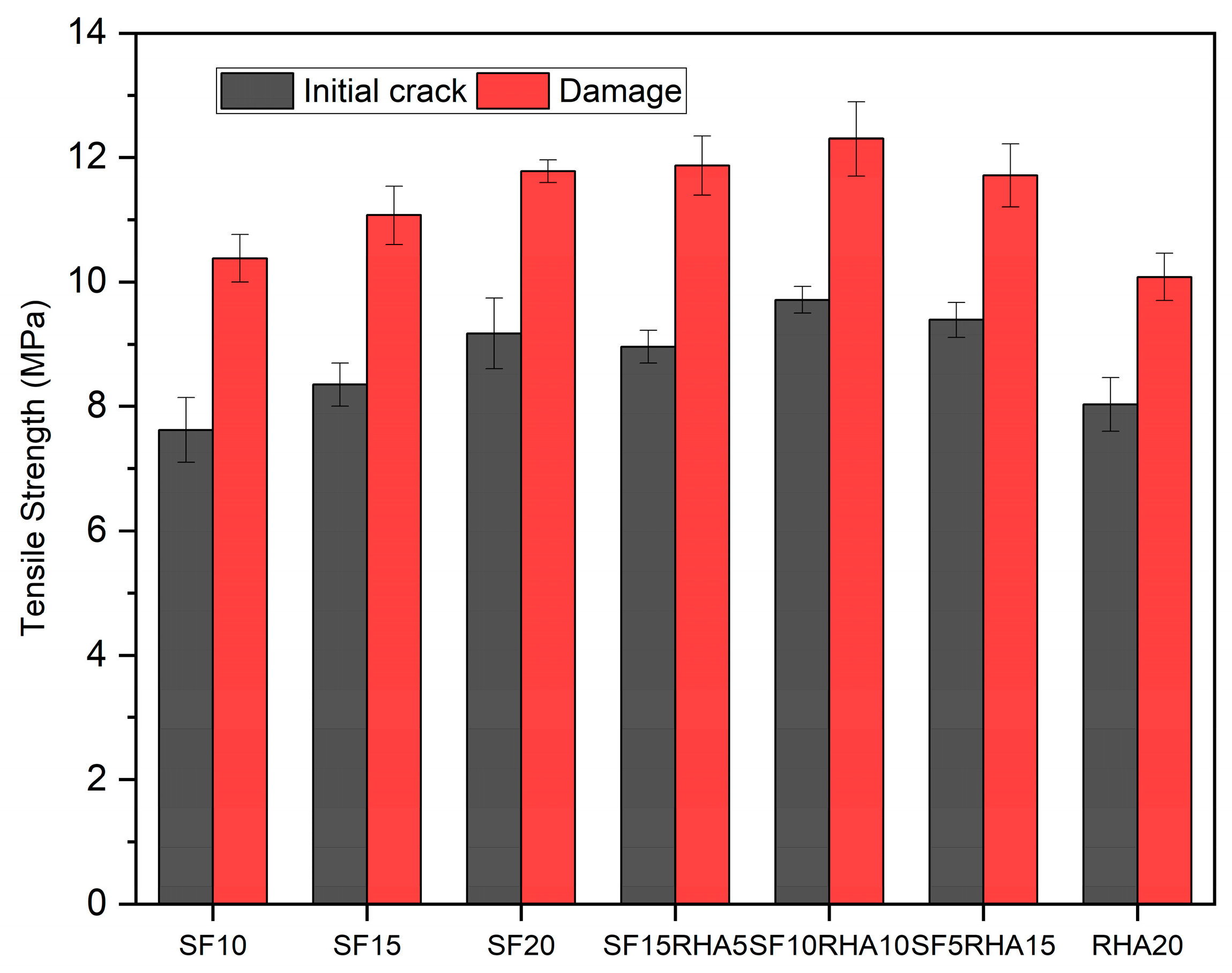
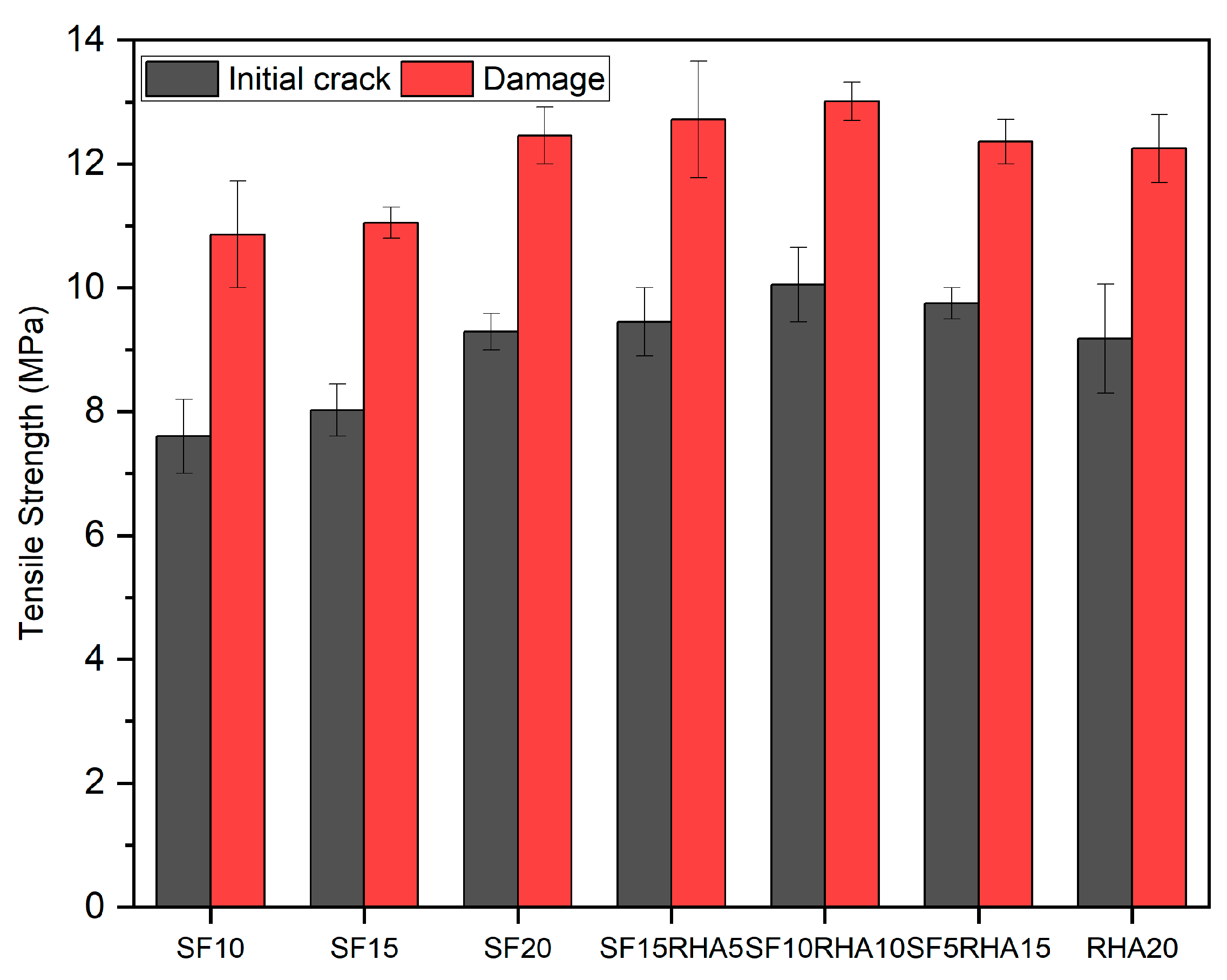
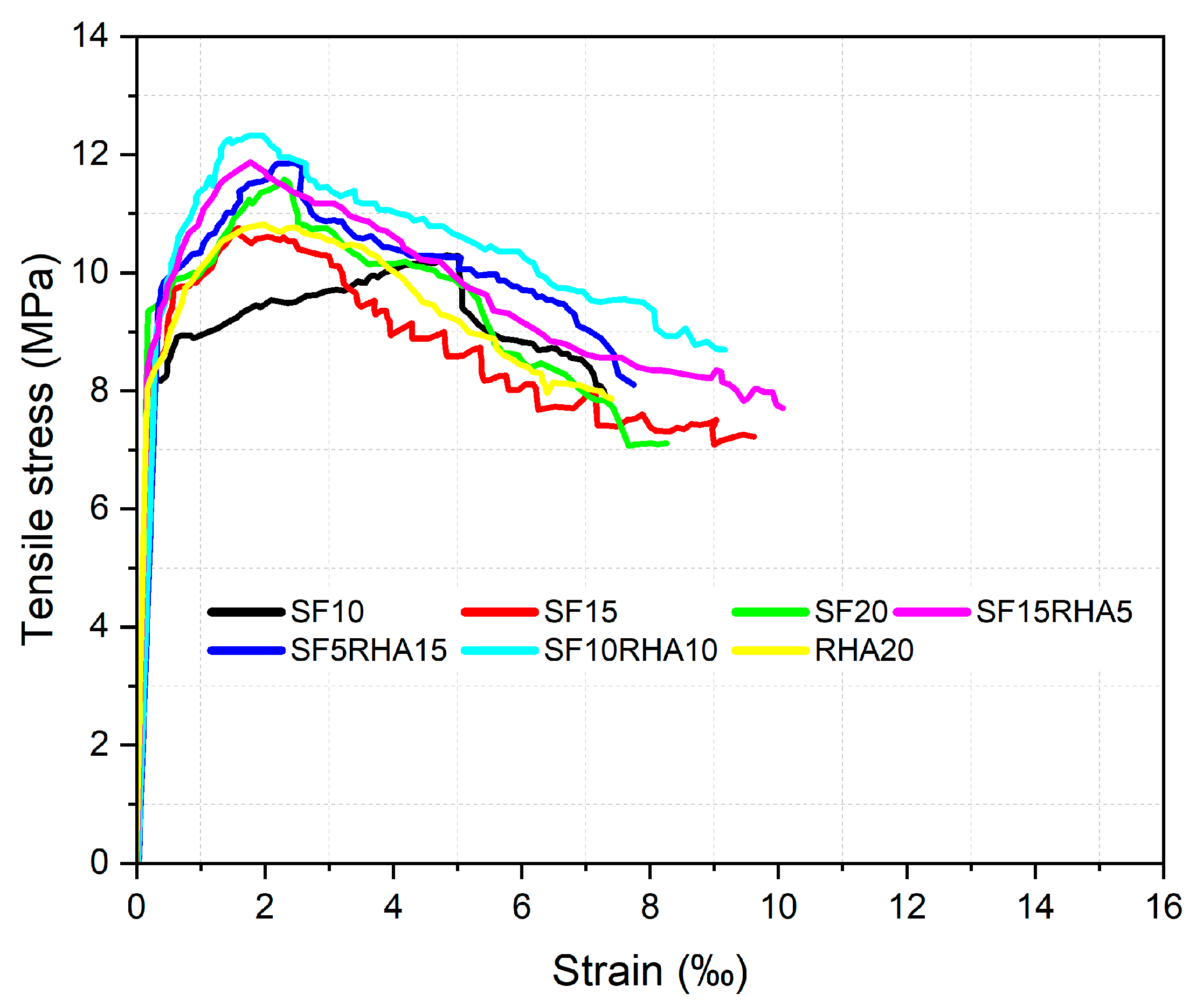
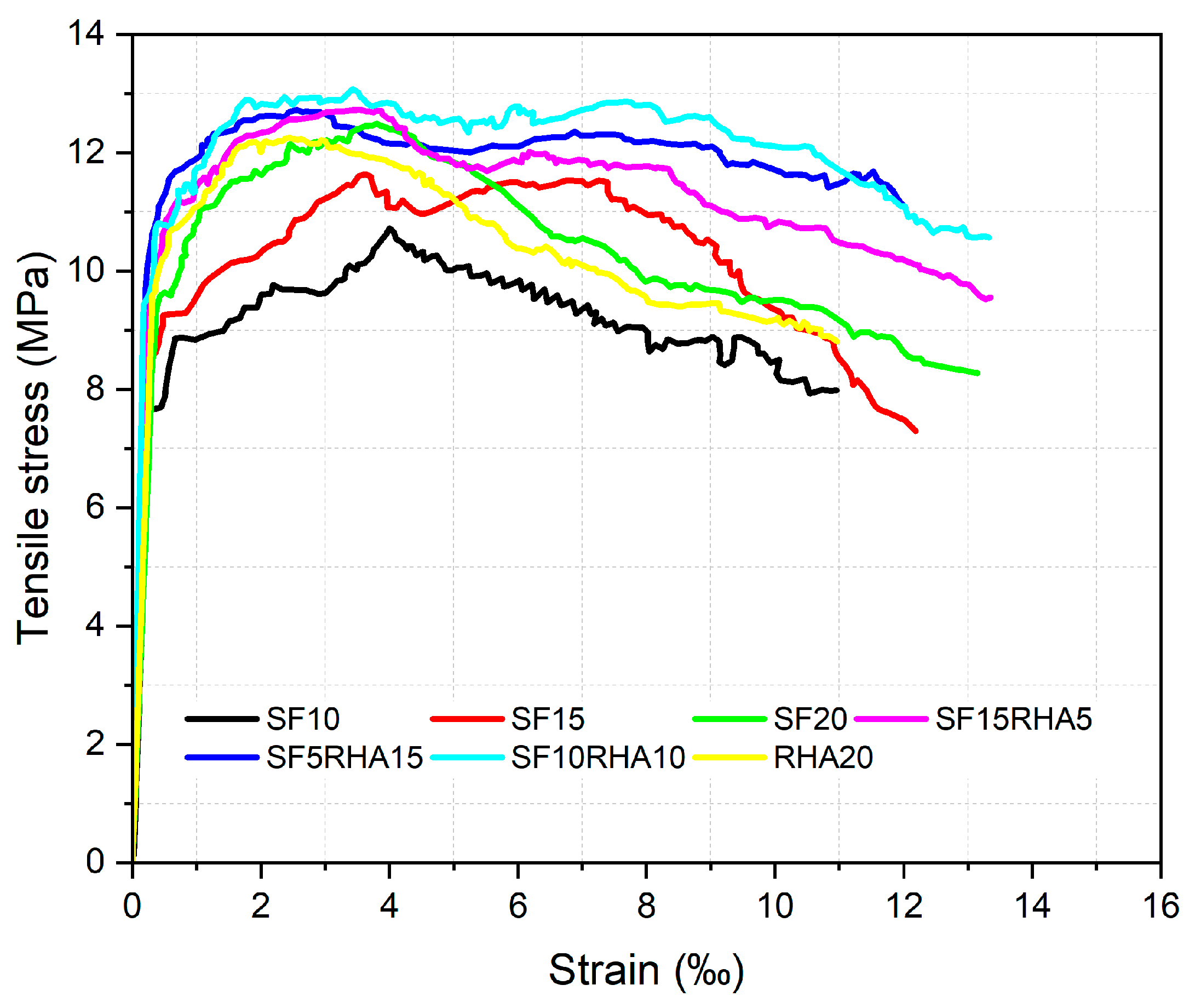
| Materials | SiO2 | Fe2O3 | CaO | MgO | Al2O3 | SO3 | Na2O | K2O |
|---|---|---|---|---|---|---|---|---|
| Cement | 17.23 | 3.45 | 64.56 | 2.11 | 3.98 | 4.33 | 0.15 | 0.89 |
| SF | 91.6 | 0.2 | 0.3 | 0.4 | 0.58 | 0.1 | 0.16 | 0.65 |
| RHA | 87.4 | 0.63 | 1.15 | 0.58 | 0.82 | 0.41 | 0.38 | 2.58 |
| Materials | Specific Weight (g/cm3) | Porous Volume (kg/m3) | Humidity (%) | Loss on Heating (%) |
|---|---|---|---|---|
| SF | 2.22 | 310 | 2.6 | 0.6 |
| RHA | 2.26 | 410 | 2.3 | 1.92 |
| Mix | Cement (kg/m3) | SF (kg/m3) | RHA (kg/m3) | Fine Sand (kg/m3) | Coarse Sand (kg/m3) | Steel Fiber (kg/m3) | SP 2 (%) | w/b 1 |
|---|---|---|---|---|---|---|---|---|
| SF10 | 1035.0 | 115.0 | - | 205 | 818 | 155 | 2.4 | 0.165 |
| SF15 | 997.5 | 172.5 | - | 205 | 818 | 155 | 2.4 | 0.165 |
| SF20 | 920.0 | 230.0 | - | 205 | 818 | 155 | 2.4 | 0.165 |
| SF15RHA5 | 920.0 | 172.5 | 57.5 | 205 | 818 | 155 | 2.4 | 0.165 |
| SF10RHA10 | 920.0 | 115.0 | 115.0 | 205 | 818 | 155 | 2.4 | 0.165 |
| SF5RHA15 | 920.0 | 57.5 | 172.5 | 205 | 818 | 155 | 2.4 | 0.165 |
| RHA20 | 920.0 | - | 230.0 | 205 | 818 | 155 | 2.4 | 0.165 |
Disclaimer/Publisher’s Note: The statements, opinions and data contained in all publications are solely those of the individual author(s) and contributor(s) and not of MDPI and/or the editor(s). MDPI and/or the editor(s) disclaim responsibility for any injury to people or property resulting from any ideas, methods, instructions or products referred to in the content. |
© 2024 by the authors. Licensee MDPI, Basel, Switzerland. This article is an open access article distributed under the terms and conditions of the Creative Commons Attribution (CC BY) license (https://creativecommons.org/licenses/by/4.0/).
Share and Cite
Ngo, T.V.; Tran, V.B.; Le, B.H.; Dang, H.T.; Matos, J.; Tran, M.Q.; Dang, S.N. An Assessment of the Impact of Locally Recycled Cementitious Replacement Materials on the Strength of the Ultra-High-Performance Concrete. Appl. Sci. 2024, 14, 7484. https://doi.org/10.3390/app14177484
Ngo TV, Tran VB, Le BH, Dang HT, Matos J, Tran MQ, Dang SN. An Assessment of the Impact of Locally Recycled Cementitious Replacement Materials on the Strength of the Ultra-High-Performance Concrete. Applied Sciences. 2024; 14(17):7484. https://doi.org/10.3390/app14177484
Chicago/Turabian StyleNgo, Thuc V., Viet Ba Tran, Bao Hoai Le, Huyen T. Dang, José Matos, Minh Q. Tran, and Son N. Dang. 2024. "An Assessment of the Impact of Locally Recycled Cementitious Replacement Materials on the Strength of the Ultra-High-Performance Concrete" Applied Sciences 14, no. 17: 7484. https://doi.org/10.3390/app14177484





